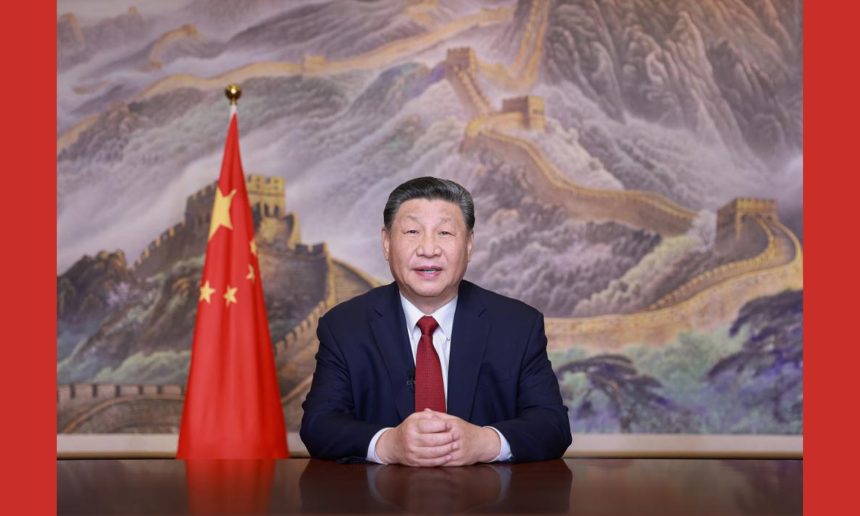By Stephen Ndegwa
As the world welcomes 2025, President Xi Jinping’s New Year address encapsulates China’s ambitions, achievements, and aspirations. Delivered amidst global economic shifts and ongoing post-pandemic recovery, Xi’s speech reflects on 2024’s milestones and outlines a visionary roadmap for the future. His remarks highlighted not only the strength of China’s economy but also the transformative strides in technology, social equity, and international partnerships.
China’s economic performance in 2024 underscores its resilience and strategic adaptability. The nation’s GDP is projected to exceed 130 trillion yuan, marking a significant recovery and reinforcing its position as the world’s second-largest economy. This impressive growth aligns with the government’s annual target of around 5 per cent expansion, achieved despite a challenging global economic landscape. A major contributor to this economic dynamism is the industrial sector, which grew by 5.8 per cent in the first three quarters of 2024. High-tech manufacturing, in particular, surged by 9.1 per cent, underlining the nation’s emphasis on advanced technologies as engines for sustainable growth.
A particularly remarkable success story is China’s leadership in the new energy vehicle (NEV) market. In 2024, over 10 million NEVs were produced, with sales projected to soon surpass those of traditional internal combustion engine vehicles. This milestone underscores China’s commitment to green energy and environmental sustainability, key pillars of its modernisation strategy.
Domestic NEV giants such as BYD and Nio have not only dominated the local market but are also becoming formidable players globally, with exports reaching record levels in Europe and Southeast Asia. These advances are emblematic of China’s ambition to position itself as the global hub for clean energy innovation.
Technological innovation remains central to China’s development narrative. In addition to its NEV achievements, China has made significant progress in space exploration. The Chang’e-6 lunar mission, for instance, successfully retrieved samples from the Moon’s far side, demonstrating its growing capabilities in space technology. Similarly, breakthroughs in quantum computing and artificial intelligence place China at the forefront of the next technological frontier. These developments have strategic implications, reducing the country’s reliance on foreign technology and bolstering its self-reliance amidst global supply chain uncertainties.
Xi’s address also celebrated China’s societal and cultural achievements, illustrating how these developments are directly impacting the lives of ordinary citizens. His visits to grassroots communities, such as the apple orchards of Gansu and the Maiji Mountain grottoes, reflect a broader commitment to inclusivity and shared prosperity. These engagements highlight the importance of rural revitalisation, a key element of the country’s development agenda aimed at reducing the urban-rural divide. Rural revitalisation efforts have seen investments in modern agricultural technologies, improved infrastructure, and enhanced access to education and healthcare, transforming previously neglected regions into hubs of productivity.
On the international stage, Xi emphasised China’s role as a partner in global progress. The successful hosting of the Forum on China-Africa Cooperation’s Beijing Summit in 2024 highlighted Beijing’s deepening ties with the Global South. Major infrastructure projects completed under the Belt and Road Initiative have had transformative effects, from new railways in East Africa to port developments in South Asia. As the BRI enters a “substantive phase,” its focus is shifting toward higher-quality, sustainable projects that integrate green technology and local capacity-building.
China’s engagement in multilateral platforms such as BRICS, the Shanghai Cooperation Organisation, and the G20 further illustrates its role as a leader in advocating for reforms in global governance. The success of the recently launched BRICS payment system, designed to reduce reliance on the US dollar in cross-border trade, underscores China’s strategic vision for fostering economic autonomy among developing nations. This vision aligns with its broader goal of promoting a multipolar world order that accommodates diverse development models.
Despite these achievements, challenges remain. The real estate sector, a cornerstone of China’s economy, continues to grapple with high debt levels among developers such as Evergrande and Country Garden. Local government debt also poses risks to fiscal stability. Additionally, demographic challenges, including an ageing population and declining birth rates, weigh on long-term growth prospects. To address these issues, Beijing has implemented policy measures, including interest rate cuts and fiscal support for struggling sectors. Efforts to boost domestic consumption through e-commerce innovations and incentives for middle-income households are also in play.
Xi’s vision for the future is deeply tied to the concept of Chinese modernisation. This model integrates economic progress with cultural and environmental harmony, ensuring that no region or demographic is left behind. The concept extends beyond national borders, as seen in China’s advocacy for global cooperation and its call to build a “shared future for mankind.” Initiatives such as the Global Development Initiative and the Global Security Initiative exemplify this approach, aiming to address pressing issues like poverty, climate change, and regional conflicts through inclusive dialogue and practical solutions.
Xi’s speech not only inspires confidence within China but also sends a message of hope and collaboration to the global community. In 2025, China’s continued pursuit of innovation, inclusivity, and international partnerships positions it as a critical player in shaping a harmonious and prosperous global landscape. Xi’s address underscores an unwavering commitment to these ideals, making the coming year one of promise and potential for both China and the world.





